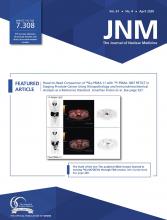TO THE EDITOR: In a recent paper, Giesel et al. analyzed the tissue biodistribution and preliminary dosimetry of 2 quinoline-based PET tracers that act as fibroblast activation protein (FAP) inhibitors, namely, 68Ga-FAPI-2 and 68Ga-FAPI-4 (1). The authors reported a fast clearance via the kidneys, a low tracer uptake in normal organs, equal tumor-to-background contrast ratios at 1 h after injection, and an almost equal uptake in comparison with 18F-FDG. However, from 1 to 3 h after injection, in contrast to 68Ga-FAPI-4, which displayed a prolonged tumor retention (25% washout), 68Ga-FAPI-2 tumor uptake decreased by 75%, thus reflecting release of the tracer from the malignant tissue. This difference explains why a companion paper by Kratochwil et al. used 68Ga-FAPI-4 for identifying the most promising indications for future application (2).
We suggest that 68Ga-FAPI-2 trapping reversibility, evidenced by a decrease in tumor uptake observed at late imaging, might prove an asset for PET quantitative imaging. Figure 2, by Giesel et al., shows 68Ga-FAPI-2 and 68Ga-FAPI-4 maximal SUV (SUVmax) at 10, 60, and 180 min after injection in 2 patients with metastasized breast cancer, respectively (1). Because the 2 tracers have rapid clearance from blood, we assume their input function (IF) has become negligible at 60, and, a fortiori, at 180 min after injection. Thus, a previously published method designed for 18F-FDG may be adapted to 68Ga-FAPI-2 and 68Ga-FAPI-4 for assessing their release rate kB (in min−1; Eq. 3 in Laffon et al. (3)). For the sake of clarity, let us assume an IF monoexponential decay with decay-corrected time constant α and initial amplitude AP(t = 0) (in min−1 and kBq.mL−1, respectively). The decay-corrected tissue activity concentration related to trapped tracer (in kBq/mL), which is proportional to SUVmax, can be approximated from 60 to 180 min after injection, by: Eq. 1where Ki is the uptake rate constant of the tracer (in mL.min−1.mL−1). Fitting the outer extreme metastasis data (extracted with the WebPlotDigitizer software) at 60 and 180 min after injection in Figure 2 with a monoexponentially decaying function leads to the following range for kB: 0.01435–0.01439 and 0.00129–0.00212 min−1 for 68Ga-FAPI-2 and 68Ga-FAPI-4, respectively. For comparison, kB for 18F-FDG trapping in the normal human liver has been estimated to be 0.00650 min−1 on average (4). It is noteworthy that, because only 2 time points were analyzed and only 1 patient per tracer was examined in Figure 2 by Giesel et al., the assessment of kB measurement uncertainty is out of the scope of the current paper (1). Therefore, additionally to SUV, we suggest that one could take advantage of the significant 68Ga-FAPI-2 trapping reversibility to better characterize tumors by means of calculating kB. Furthermore, the above-proposed fitting of kB might be easily performed at the voxel level, thus allowing parametric imaging of tracer release. Finally, let us note that a multiexponentially decaying IF does not alter the current line of argument.
Eq. 1where Ki is the uptake rate constant of the tracer (in mL.min−1.mL−1). Fitting the outer extreme metastasis data (extracted with the WebPlotDigitizer software) at 60 and 180 min after injection in Figure 2 with a monoexponentially decaying function leads to the following range for kB: 0.01435–0.01439 and 0.00129–0.00212 min−1 for 68Ga-FAPI-2 and 68Ga-FAPI-4, respectively. For comparison, kB for 18F-FDG trapping in the normal human liver has been estimated to be 0.00650 min−1 on average (4). It is noteworthy that, because only 2 time points were analyzed and only 1 patient per tracer was examined in Figure 2 by Giesel et al., the assessment of kB measurement uncertainty is out of the scope of the current paper (1). Therefore, additionally to SUV, we suggest that one could take advantage of the significant 68Ga-FAPI-2 trapping reversibility to better characterize tumors by means of calculating kB. Furthermore, the above-proposed fitting of kB might be easily performed at the voxel level, thus allowing parametric imaging of tracer release. Finally, let us note that a multiexponentially decaying IF does not alter the current line of argument.
To conclude, 68Ga-FAPI PET/CT is a promising new diagnostic method for imaging various cancers that overexpress FAP (1). We suggest that the choice between 68Ga-FAPI-2 and 68Ga-FAPI-4 should not be only based on the criterion of reversible versus irreversible (or nearly) trapping of the tracer, even if the latter is an indubitable advantage for a theranostic purpose. Indeed, one could also take advantage of the significant trapping reversibility of 68Ga-FAPI-2 to better characterize malignant tissues. Furthermore, we suggest that performing both uptake and release quantitation of 68Ga-FAPI-2 trapping might be an innovative tool for assessing the response to treatment.
Footnotes
Published online Aug. 16, 2019.
- © 2020 by the Society of Nuclear Medicine and Molecular Imaging.







